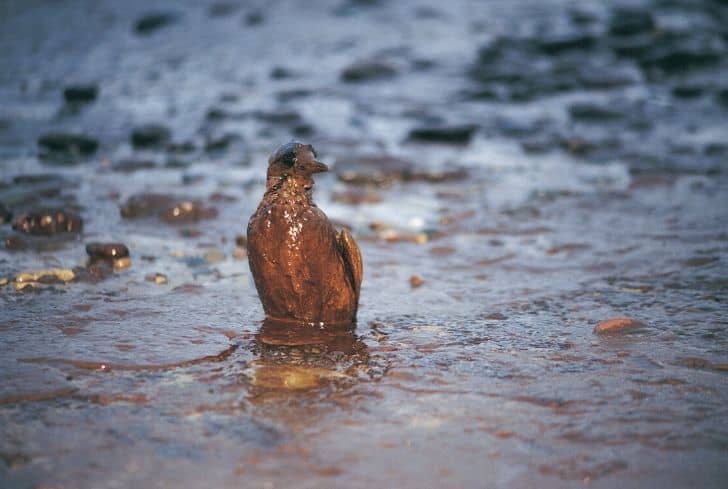How Waste Oil Affects the Environment
April 13, 2022

Waste oil has continuously ranked among the top pollutants in the world, especially in bodies of water (www.nrdc.org). Many drains go straight to rivers, streams, and lakes, and allowing oil to enter one can have the same result as dumping it directly into one.
Waste oil pollution has a disastrous effect on the aquatic ecosystem because it forms a thin coating on the surface that prevents oxygen from reaching the plants and animals that dwell in the water. Among the effects of waste oil pollution are:
- Harms animals and insects
- Blocks plants from photosynthesis, disrupting the food chain and taking a long time to recover
- Wildfowl are particularly vulnerable to waste oil pollution, both because of damage to their plumage's waterproofing and because they consume the oil while they preen. Water voles and other mammals may also be affected by oil slicks on water surfaces
Waste oil in the ground and soil can coat or kill creatures that are needed to keep the environment in balance. Waste oil can seep into groundwater systems if it is poured down the drain or spilt on the ground. In fact, a million litres of water can easily be contaminated even by one litre of waste oil.
When waste oil is burned in furnaces without being treated, hazardous chemical substances are released into the atmosphere, contaminating and poisoning the air we breathe. As a result, it is prohibited to dump or burn waste oil without first treating it.
The environmental law mandates the safe storage, collection, and recycling of waste oil while adhering to National Environment Agency’s strict guidelines. Industrial machinery, motor vehicles, mining equipment, and agricultural equipment are only a few of the sources of waste oil – some even come from regular households. It is critical that all used oil, even that produced by DIY mechanics, farmers, and small businesses, be collected and responsibly recycled.
Waste oil impacts on humans
In addition to its adverse effects on wildlife, waste oil contamination may also make water unfit for agriculture and disrupt the operation of water treatment plants. Waste oil can contaminate drinking water supplies and is very costly to clean up.
If waste oil is spilled near a building, oil vapours may infiltrate the building, rendering it unfit for occupation. This could mean the building can be rendered unusable and unlivable until costly repair work is done. In extreme cases, the building may also need to be demolished and rebuilt.
Through inhalation, ingestion, or skin contact, pollutants in used oil can cause a variety of illnesses and diseases in humans and other species. Lipid pneumonia, lipid granuloma in the lungs, eczematous and contact dermatitis, folliculitis, oil acne, and melanosis have all been reported as side effects of waste oil exposure.
Squamous cell carcinoma of the skin and scrotum, as well as bladder and liver cancer, can all be caused by used oil contamination. The presence of PAHs in used oil is mostly responsible for these effects, but benzene, toluene, and chlorinated solvents can also contribute to toxicity. Some of these additives have the potential to harm human health and the environment, while others are completely safe. Physical and chemical impurities are present in used oil as a result of physical pollution, chemical reactions, and wear and tear that occurs throughout its usage.
Oil waste/spills affect ecosystem
Oil waste contamination affects sea life primarily, as it can impact their food sources, making them less available or of worse quality. Furthermore, oil has an impact on reproduction and breeding, such as polluting bird or turtle nests on the beach, reducing viability, and suffocating unhatched chicks. Oil-affected females may also lay eggs with thinner shells that are more likely to shatter, leading to species extinction in the long run.
Case study: Gulf of Mexico spill 2010
With more than 134 million gallons of oil spilled into the Gulf of Mexico in 2010, the Deepwater Horizon slick became the greatest ever marine oil spill in US history. Scientists have discovered that the influence is significantly longer lasting than many thought after more than a decade.
Oil levels throughout the miles of the damaged shoreline were determined to be 100 times higher than prior levels in the summer following the slick. However, eight years later, the sediment levels in the surrounding wetlands were still ten times greater than they were before the catastrophe.
Even a year after the accident, research reveals that droplets continued to descend to the seafloor. It had an impact on sedimentation rates, which are an important food supply and habitat for many sea life. Many deep-sea species that live near the sediment surface may even take decades to recover.
A study of bottlenose dolphins that were exposed to oil during the Deepwater Horizon disaster also found that the oil spill may have had a long-term effect on their immune systems, making it harder for them to fight diseases.
Waste oil disposal, treatment & recycling
Waste oil contamination is a very serious problem and it affects everyone and everything. Never underestimate the value of keeping your waste motor oil or cooking oil safely stored and disposed of via the correct disposal channel.
There are 10 ways in which waste oil can be disposed of:
1. Properly storing waste oil for collection and recycling
The procedure of efficient oil disposal begins with appropriately storing waste oil in an appropriate container. The safest method is to transport the oil in the original containers that came with it. To avoid leaks that could be damaging to the environment, the storage container should always be properly closed.
Antifreeze, paint, or chemicals should be avoided when picking a storage container, especially if the oil is going to be recycled or reused. To avoid spillage, ensure that the used oil is carefully transferred into the storage container. The storage container should be properly labelled after it has been tightly shut.
2. Know what you're disposing of and how to do it correctly
Before you dispose of waste oil, be sure you have a thorough understanding of what you're throwing away. This will assist you in determining how to properly dispose of it. Burning a material you don't completely understand, for example, can put you in grave danger.
Although certain oils may be securely disposed of using heaters and boilers, some may require the use of disposal services. You'll be able to choose the safest and most effective form of disposal once you understand the oil you're working with.
3. Keep waste oil in a secure location
Because you are unlikely to dispose of the waste oil the same day you replace it in your machine, make sure it is kept in a secure location where no one without the proper information can access it, especially if there are children or dogs present. To minimise confusion, waste oil should not be kept in the same location as unused oil, especially if it is stored in regular fuel storage.
4. Never pour the oil down the sink or into the septic tank
Never dump used cooking oil, grease, or any other oil down the drain or into the septic system. Sewers and drainage systems become clogged. It should be properly stored and labelled as described above with the goal of properly disposing of it later, either by recycling it or hiring an expert.
5. Maintain your vehicle/equipment properly
Maintenance of your equipment or vehicle is the first step in effective waste oil disposal. Well-maintained equipment or vehicles are simpler to clean and decrease total oil leakage and the demand for fresh oil, lowering the overall need for used oil disposal.
6. If you're going to burn the oil as a disposal method, make sure you have the right heater
If you decide to burn your oil on your own, make sure you use the appropriate heater. Burning waste oil is a safe and cost-effective approach to recycle and convert spent oil into something more useful.
However, make sure you're using an efficient heater that's developed specifically for waste oil disposal. The waste oil burners are composed of carbon steel and should not be confused with typical cast iron boilers.
7. Use waste oil disposal equipment that has been approved
It's worth mentioning that some waste boilers are only capable of burning a certain range of oils. Low-quality or unreliable equipment can only burn a restricted spectrum of old oils; hence, high-quality equipment is required. When purchasing waste oil disposal equipment, make certain that it has been approved by the right authorities. Most approved boilers and heaters can safely and effectively burn a wide range of waste oils.
8. Use the oil disposal guidelines that have been established
When disposing of waste oil, follow the manufacturer's instructions to the dot. Always consult the instructions if you're unsure how to properly dispose of old oil. Different boilers have different features that are meant to guarantee that waste oil is properly disposed of. Others are designed to make the disposal process as simple as possible, therefore it's important to get to know the equipment before utilising it.
9. Get rid of everything that comes into contact with the waste oil
Most people forget to dispose of other contaminated pieces while disposing of waste oil. It is usual practice to discard the oil and forget about the oil filter after changing the engine oil, but this should not be the case. Because the oil filter retains oil contaminations, it can have the same environmental impact as the used oil. This emphasises the importance of properly disposing of it.
10. Engage the experts
You should always contact a local waste oil collector if you do not have the capacity or ability to dispose of the waste oil. The majority of waste oil service companies have the appropriate equipment and facilities to ensure that waste oil is disposed of safely and effectively. When using such services, the level of experience and pricing should also be taken into account.
Conclusion
Waste oil that is collected and disposed of will go through a treatment and recycling process after its analysis and classification process. After analysis, the waste oil will either be recycled as lubricating oil, heavy oil or supplemental fuel.
At GreenTec Energy, we are certified waste oil collectors under NEA (TIWC & GWC - Toxic Industrial Waste Collectors & General Waste Collectors). Get in touch with us to learn more about safe waste oil disposal. Together, we make Singapore a cleaner and safer place to live in.
 GreenTec Energy Pte Ltd (GTE) is a waste management company located in Tuas, Singapore.
GreenTec Energy Pte Ltd (GTE) is a waste management company located in Tuas, Singapore.
Our service includes Industrial waste, Oily waste, Marine waste.
To provide a hassle free solution to our customer is always the key approach and to ensure a win-win situation towards. As a NEA approved environmental company in Singapore, we take all our services seriously and to ensure maximum safety with compliances applied. Every step of our disposal processes are also designed to meet NEA & SCDF requirements, with latest treatment facilities and laboratories to test and treat all incoming waste before disposal.
GTE operates a total land area of about 100,000sqft at 14 Tuas South Street 12 Singapore 636953. With our comprehensive logistics and transportation fleet, we provide prompt and efficient services in transportation of waste to our premises.



